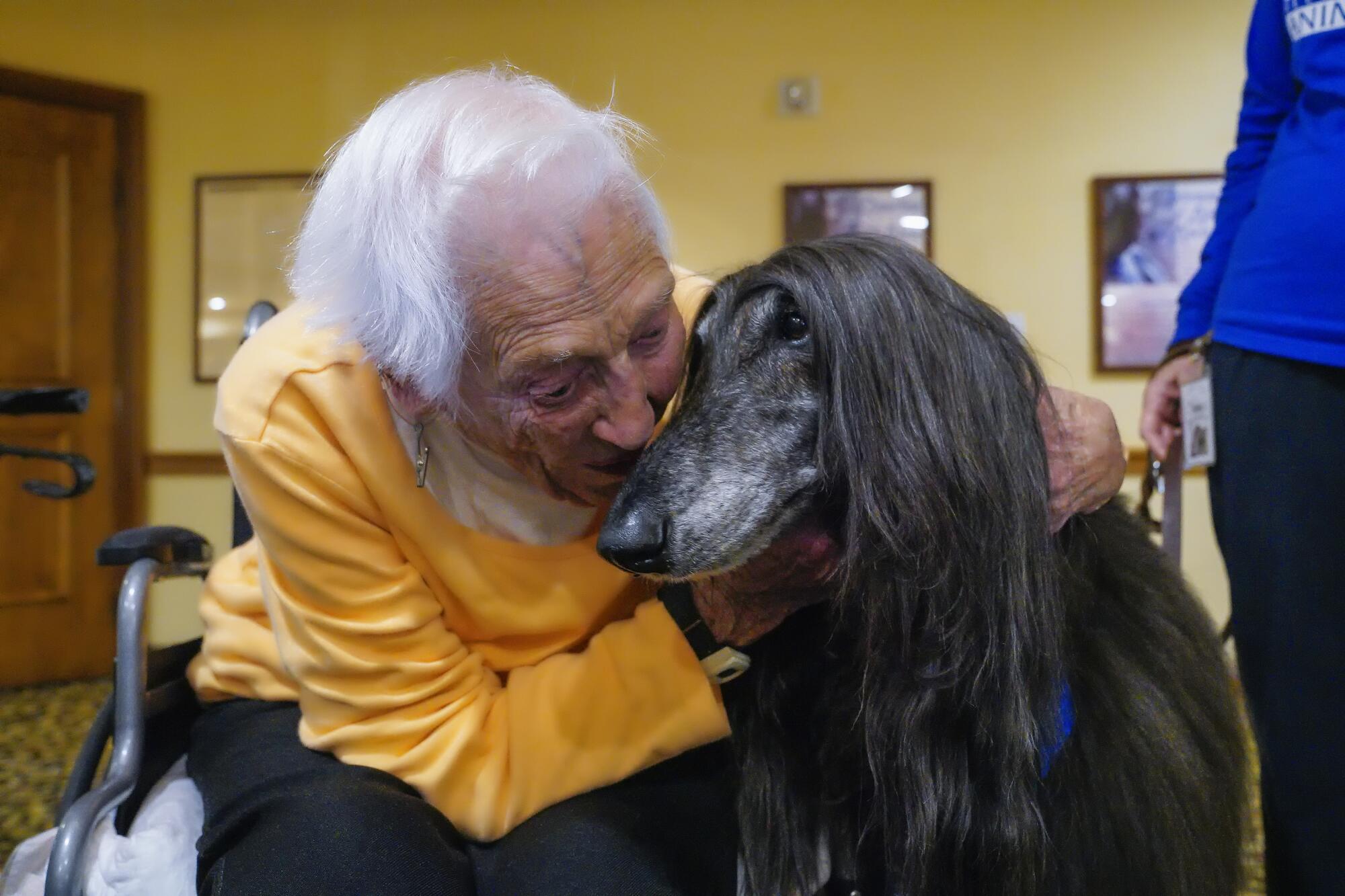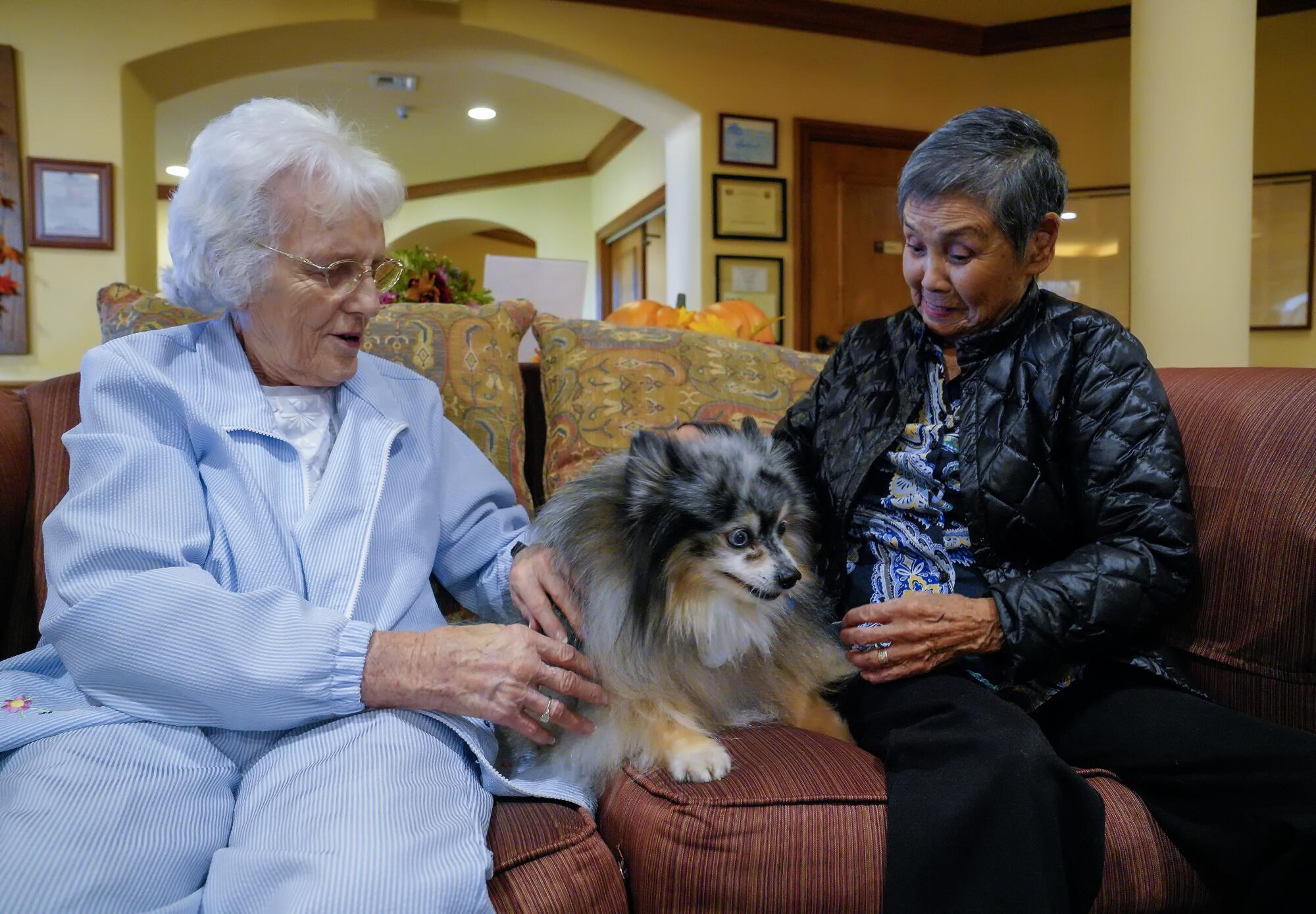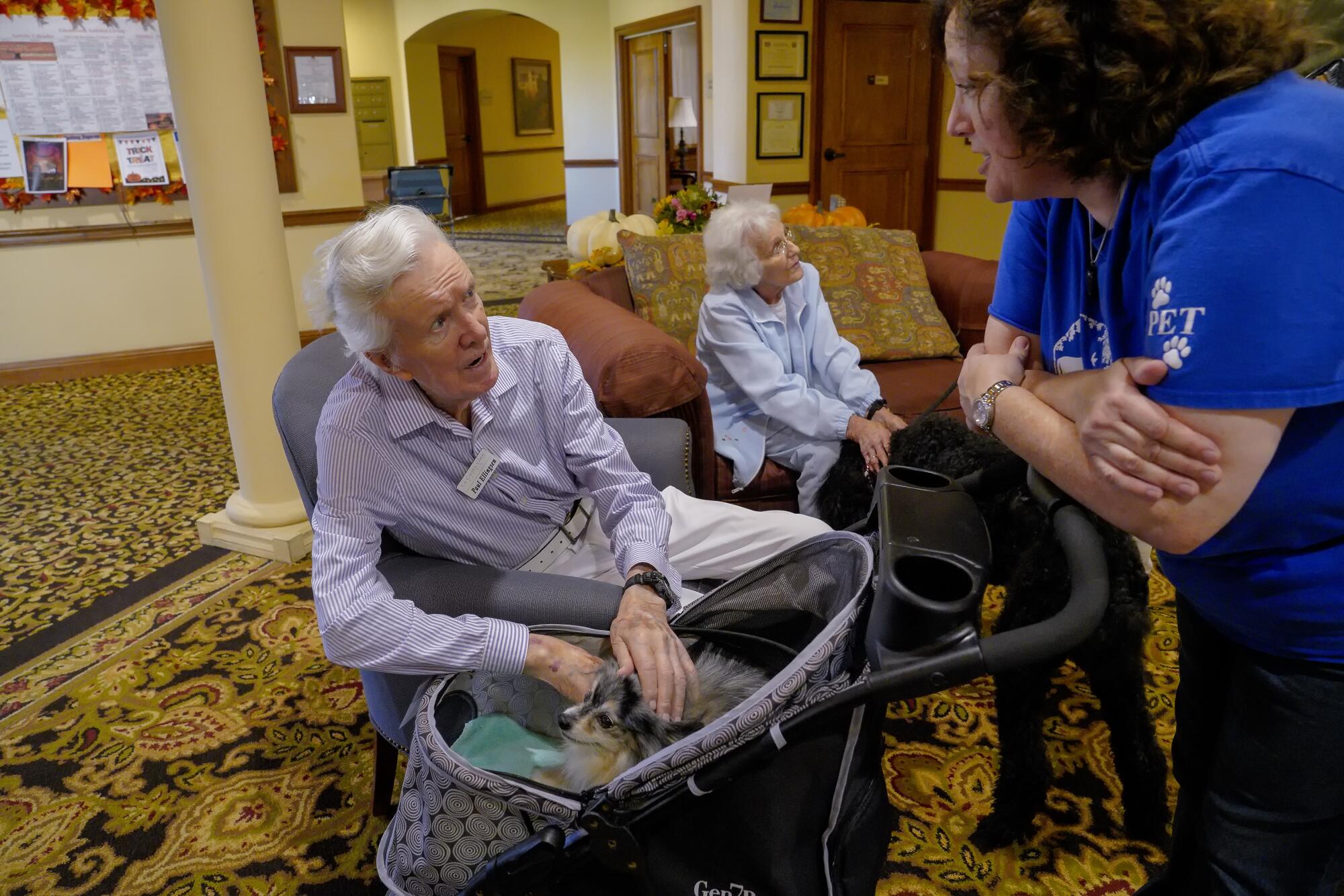
- Share via
SAN DIEGO — Pet owners know the many joys of pet ownership firsthand. They have a greeter waiting by the door when they get home from work, a friend to walk with around the neighborhood, and a fur baby to snuggle with while watching a movie on the couch.
Although not everyone is able to care for a pet, the benefits of spending time with them can be experienced through animal-assisted therapy. The practice is part of an ever-growing collection of methods to improve conditions for aging populations, including for people with dementia.
Several local organizations, such as San Diego Humane Society and the Helen Woodward Animal Center, visit senior living facilities, hospitals and private residences so that those who can’t own pets can still enjoy them.
Studies have shown there are physical health benefits of interacting with animals such as lower blood pressure, stress reduction, lower cholesterol and muted pain sensations, said Robin Cohen, the pet encounter therapy manager at Helen Woodward Animal Center.
There is also an emotional benefit, Cohen said.
“There’s complete acceptance that comes from an animal: the unconditional love. There’s no judgment, they listen, they accept and they love,” she said.
Alex Psirides, co-director of the intensive care unit at Wellington Hospital in New Zealand, is one of the leading researchers globally in the field of animal-assisted therapy.
He said he was initially skeptical that there would be therapeutic benefits of animal visits for patients. Wellington’s program began with patients requesting that their family pets come in for visits and later was expanded to bring in therapy animals for the broader population in the intensive care unit.
After seeing how patients responded, Psirides was sold on animal therapy and has written a chapter about his research for an upcoming critical care textbook.
“I think it jars them out of where they are, and kind of removes them from the reality of where they are for just a brief period of time,” Psirides said. “It provides some respite from what’s happening to them.”

Cohen at Helen Woodward said she has seen nonverbal trauma patients open up to the animals they are petting, and then begin to speak about their experience for the first time.
“Some of the people we visit have often been isolated from others and maybe have a hard time connecting with people, but with the animals it’s such a pure connection and a beautiful connection that they offer,” she said.
Interacting with animals can also help trigger memories for people with Alzheimer’s disease or other dementia, Cohen said.
At the Vi at La Jolla Village retirement community in northwest San Diego, two black Labradors from Paws for Purple Hearts came to visit recently. Resident Lynn Mooney said petting George and Sandy reminded her of the German shepherd she used to have named Rin Tin Tin.
“I love it. Whenever they come, I’m there,” Mooney said.
George and Sandy are in training to become service animals for veterans with post-traumatic stress disorder, traumatic brain injuries or military sexual trauma. During the dogs’ visit to the Vi, the residents excitedly invited the pair into their rooms as they traveled through the hallways.
Luis Islas, activity assistant at the Vi, said the pets can especially help those who have had a bad night of sleep or are otherwise upset. The Vi offers assisted living, memory care and skilled nursing.
“When the dogs come in, it totally changes their mood,” Islas said. “They’re up, they’re happy, they have a smile on their face, so you can see the difference right there.”
In other cases, knowing about upcoming visits can help encourage healthy behavior, said Laura Leonard, pet-assisted therapy specialist for San Diego Humane Society.
“We’ve had staff tell us that participants who might not normally do their own personal hygiene are getting ready for the day, brushing their teeth, brushing their hair, taking showers so that they can participate in the program that we’re offering,” Leonard said.
Animal-assisted therapy can also improve working conditions for staff at care facilities and hospitals by helping to reduce their stress, Psirides said.
“It’s one of those rare interventions that has benefited both patients and staff simultaneously, and I can’t think of many of the things we’ve done as a critical care unit that’s actually done that,” Psirides said.

If someone is allergic to cats or dogs, they can get benefits from visiting with reptiles and birds or watching a fish tank. A study from Purdue University found that when patients with Alzheimer’s disease were exposed to fish tanks, they were more relaxed, ate as much as 21% more food and experienced a decrease in instances of physical aggression and wandering.
Even robotic pets can be used as a low-maintenance replacement for real animals. Researchers at the University of Auckland found that dementia patients experienced improved facial expressions and communication with day care center staff after interacting with the Paro therapeutic robot, which emulates a harp seal pup.
Those living at home independently or with their families can also interact with therapy animals.
San Diego Humane Society hosts a “fur fix” event every Thursday and every other Saturday at which people can pet and play with animals. The nonprofit also has a small team of volunteers in a welcome wagon program that bring dogs to visit people in their homes, Leonard said.
The American Journal of Infection Control recommends a set of guidelines when it comes to bringing animals into long-term care facilities and hospitals. Certain animals are considered at a higher risk of causing infection or injury to humans, such as reptiles, amphibians, nonhuman primates, mice, rats, hamsters and gerbils.
Patients, visitors and healthcare employees should also clean their hands with alcohol-based hand sanitizers before and after interacting with the animals.
Regardless of the ways people get to visit with animals, interacting with pets and the human volunteers who accompany them can help decrease feelings of social isolation.
“Sometimes they’ll pet the animal for a couple minutes, and then they just start discussing stories with our volunteers,” Leonard said. “They might not have family that ever visits them in their care facilities, so our volunteers become companions for them.”
Interested in animal therapy?
San Diego Humane Society
Phone: (619) 299-7012
Website: http://bit.ly/SDHumane
Helen Woodward Animal Center
Phone: (858) 756-4117
Website: http://bit.ly/HelenWoodward
Paws for Purple Hearts
Phone: (707) 238-5110
Website: https://pawsforpurplehearts.org/
Mapp writes for the San Diego Union-Tribune.
More to Read
Sign up for Essential California
The most important California stories and recommendations in your inbox every morning.
You may occasionally receive promotional content from the Los Angeles Times.













